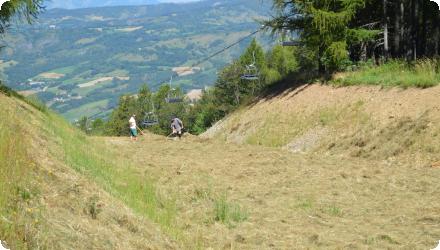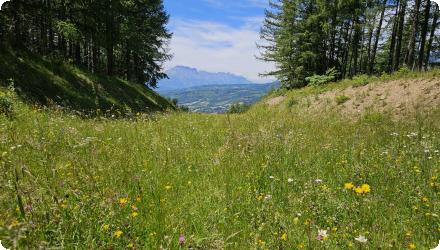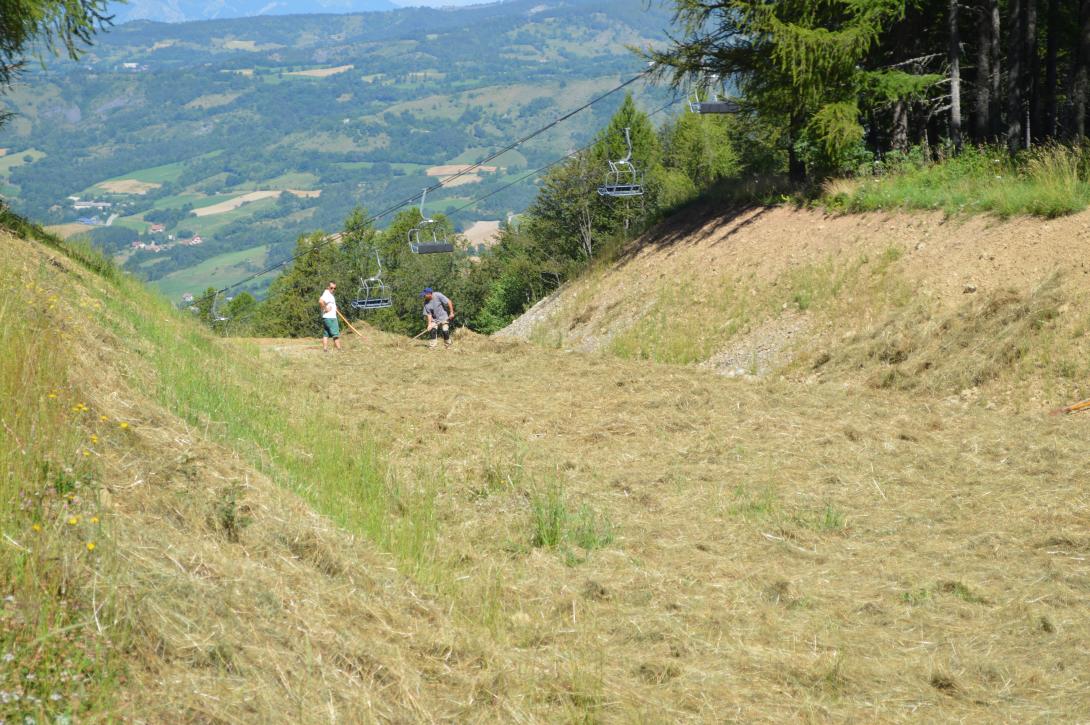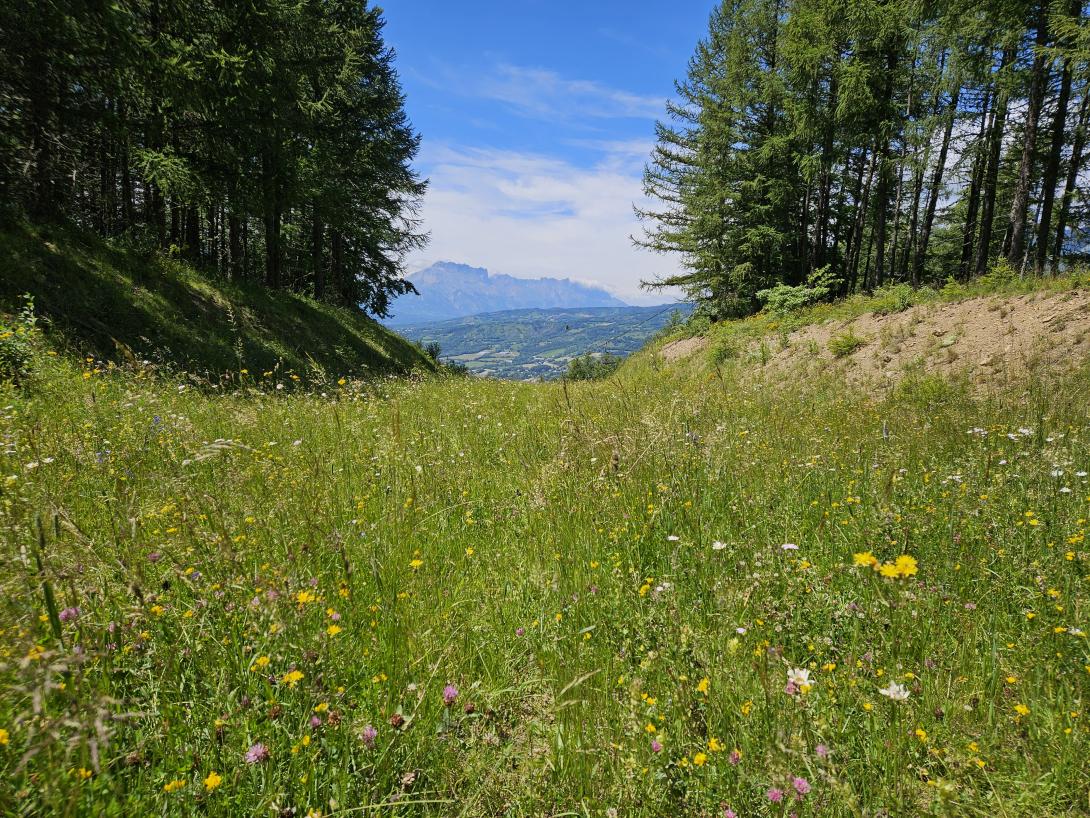Last update
2025
Summary
In Saint-Léger-les-Mélèzes (Hautes-Alpes), a ski slope stripped by 2015 remodeling linked with works around the upstream Libouze snowmaking reservoir was revegetated to curb erosion, improve snow retention and summer landscape, and allow grazing. The “green hay” transfer (hay harvested nearby and spread fresh) was applied in July 2016 after earlier attempts with commercial seed failed. Monitoring on fixed quadrats recorded rapid establishment of native meadow species; the slope was left ungrazed for two years to ensure rooting. Results reported by local stakeholders indicate reduced erosion and better snowpack persistence compared to conventional seeding. The operation formed part of the Sem’ les Alpes programme on local-provenance seed solutions for Alpine grasslands. Since then, CBNA has documented a second site in the resort (“Pied de station”, ~3,000 m²) using composted sewage sludge plus green hay, and regional partners and media have highlighted the Vernie Rouge case in compilations of ecological engineering exemplars.
Position
Latitude
44.642134
Longitude
6.208311
Project
NWRM
National Id
France_16
Installation date
2016
Implementation Status
RBD code
FRD-Le Rhône et les cours d'eau côtiers méditerranéens
Transboundary
0
Photo gallery
Location of the project
The Vernie-Rouge trail is located in the Saint-Léger-Les-Mélèze resort, in the adhesion zone of the Les Ecrins national park. Facing North, it is located at an altitude of 1300-1500 m above sea level. It is identified as mountain hay meadow (priority habitats) by the EUNIS habitat classification. It has been remodeled in 2016, leading to a nude soil which was rapidly eroded by rain events and revegetalisation with commercial seeds have not succeeded.
NUTS Code
FR82 - Provence-Alpes-Côte d'Azur
Project's objectives
Quickly reduce the phenomenon of water erosion.
Improve the conservation of the snow cover on the ski slope.
Enable the ski slope to better blend into the landscape and, eventually, allow grazing by livestock during the summer.
Improve the conservation of the snow cover on the ski slope.
Enable the ski slope to better blend into the landscape and, eventually, allow grazing by livestock during the summer.
Involved Partners
| Authority type | Authority name | Role | Comments |
|---|---|---|---|
Climate zone
warm temperate dry
Temperature
5.9 °C
Annual rainfall range
900 - 1200 mm
Elevation range
1382 m
Slope range
15-30 %
Vegetation class
Alpine herbaceous vegetation : mountain hay meadow
Water bodies: Ecological Status
Good
Water bodies: Chemical Status
Good
Water quality status
Basin issues focus on hydromorphology & continuity, low-flow biological continuity, and abstractions.
Project scale
Micro
Project scale specification
Covers only a single ski slope.
Project area
0.27
Area specifications
Area revegetalized.
An experimental approach to compare 5 sowing methods: green hay, dry hay, unsown control, classic commercial mix and green hay, classic commercial mix and composted sewage sludge.
Spreading green hay bales requires a bit more manual labor than other methods.
The dry hay method remains more effective than commercial seeds, but less effective than green hay. Indeed, the drier seeds tend to fall out of the bale and their germination capacity decreases over time.
Grazing on the slope was not permitted during the first two years, as the addition of nitrates early on would have been harmful to vegetation regeneration.
The dry hay method remains more effective than commercial seeds, but less effective than green hay. Indeed, the drier seeds tend to fall out of the bale and their germination capacity decreases over time.
Grazing on the slope was not permitted during the first two years, as the addition of nitrates early on would have been harmful to vegetation regeneration.
The restoration of natural grasslands on ski slopes reduces erosion while improving the landscape and allowing agricultural use during the summer months. The use of local green hay should encourage the establishment of vegetation and is more interesting for biodiversity than commercial seeds.
Total cost
€ 1,000
Costs total information
The hay and the farmer's labor cost €358.
Monitoring operations costs approximately € 150 per year.
Monitoring operations costs approximately € 150 per year.
Financing authorities
Type of funding
Local funds
Comments
self-financing
Compensations
0
Policy context
Ski resorts commonly face erosion problems on their ski slopes, which prevent the establishment of herbaceous vegetation. The absence of vegetation reduces the snowpack's shelf life and affects the quality of the landscape during the summer months.
Many ski resorts are therefore carrying out revegetation operations on their slopes in order to stabilize the soil on the ski slopes and limit erosion. However, revegetation is generally carried out with exogenous seeds that are not fully suited for local conditions and biodiversity, and that also have a low species diversity. The runway has been remodeled, with its ground exposed. At the same time, a retention basin was dug upstream of the runway, causing a lot of soil material to be deposited on the runway. These materials were removed at the first rainfall, which made the ski slope very stony. Attempts to vegetate the ski slope following the work did not work, and it remained bare. The objectives of the prairie revegetation were to improve snow cover conservation and control erosion, while allowing the ski slope to be landscaped and grazed in summer. It was not grazed on the first 2 years to allow its correct rooting and installation.
Many ski resorts are therefore carrying out revegetation operations on their slopes in order to stabilize the soil on the ski slopes and limit erosion. However, revegetation is generally carried out with exogenous seeds that are not fully suited for local conditions and biodiversity, and that also have a low species diversity. The runway has been remodeled, with its ground exposed. At the same time, a retention basin was dug upstream of the runway, causing a lot of soil material to be deposited on the runway. These materials were removed at the first rainfall, which made the ski slope very stony. Attempts to vegetate the ski slope following the work did not work, and it remained bare. The objectives of the prairie revegetation were to improve snow cover conservation and control erosion, while allowing the ski slope to be landscaped and grazed in summer. It was not grazed on the first 2 years to allow its correct rooting and installation.
Land ownership
Municipality of Saint-Léger-les-Mélèzes
Community involvment
No
Design consultation activity
| Activity stage | Name | Key issues | Comments |
|---|
Policy target
| Target purpose |
|---|
|
Erosion Control
|
|
Improved Biodiversity
|
Target Remarks
Biodiversity improvements are wanted, as the site is located in the adhesion zone of the national natural park "Parc des Écrins".
Policy pressure
| Pressure directive | Relevant pressure |
|---|
Policy impact
| Impact directive | Relevant impact |
|---|
Requirement directive
| Requirement directive | Specification |
|---|
Contractual arrangements
0
| Arrangement type | Responsibility | Role | Name | Comments |
|---|
Part of wider plan
1
Wider plan type
| Wider plan type | Wider plan focus | Name | Comments |
|---|---|---|---|
|
Regional
|
Environment & Biodiversity
|
Sem'Les Alpes
|
Establishment of local seed supply chains in the Alps, with European fundings.
|
Botanic survey every year or every two years is carried out by the CBNA.
Before mowing, the national alpine botanical conservatory (CBNA) conducted a comprehensive inventory of the hay meadow used to produce green hay, in order to assess the establishment of herbaceous species in the restored meadow.
Botanical monitoring of the restored site
is carried out in 15 quadrants of 50 centimeters each side, distributed over a square of 10 meters each side along 3 transects (5 quadrants per transect). All plant species present are recorded, as well as the cover of vegetation and coarse elements (>2 cm). The frequency of species presence at the area scale, specific richness, and percentage of target species are calculated from these data.
The monitoring time depends on the climatic period in the year, not a specific date. Due to global warming, a similar time regarding plants life cycle happens in 2025 2 weeks earlier than in 2016.
Botanical monitoring of the restored site
is carried out in 15 quadrants of 50 centimeters each side, distributed over a square of 10 meters each side along 3 transects (5 quadrants per transect). All plant species present are recorded, as well as the cover of vegetation and coarse elements (>2 cm). The frequency of species presence at the area scale, specific richness, and percentage of target species are calculated from these data.
The monitoring time depends on the climatic period in the year, not a specific date. Due to global warming, a similar time regarding plants life cycle happens in 2025 2 weeks earlier than in 2016.
Maintenance
Only grazing. Horse grazing (green hay areas) or sheep grazing in June and October (traditional fodder areas).
Comparison with control site
The prolongation of the winter snow cover increases the tourist appeal of the ski slope, so the economic benefits for the ski resort.
The landscape integration improved the living environment for recreational activities such as hiking, picnic, ...
The landscape integration improved the living environment for recreational activities such as hiking, picnic, ...
Hydrological effects
Slowing & storing overland flow, soil conservation, habitat creation; qualitative feedback of reduced erosion and better snow persistence on the green-hay plot vs commercial seed.
Information on runoff reduction
The year after restoration, erosion was observed in the area planted with commercial seeds, unlike the area planted with green hay. According to the Mayor of the municipality and the operator of the resort, the snow on this plot holds better than it did before it was planted.
1
After 2 years of revegetation, 73% of the procession is composed of target species (species typical of hay meadows), compared to 53% with the traditional method.
After 4 years, commercial seed mixtures (combining dry hay with commercial seed; or composted sewage sludge with conventional mixtures) showed greater ground cover than green hay or dry hay alone. Specific species richness was significantly higher with green hay during the first year, but then declined over time (except for the commercial seed in composted sewage sludge, which remained lower throughout). The proportion of target species varies between methods : 48.5% with green hay - well above the 20 to 30% achieved by other seeding methods. Thus, the green hay technique makes it possible to establish nearly half of the species found in the reference ecosystem, namely the mountain hay meadow.
After 4 years, commercial seed mixtures (combining dry hay with commercial seed; or composted sewage sludge with conventional mixtures) showed greater ground cover than green hay or dry hay alone. Specific species richness was significantly higher with green hay during the first year, but then declined over time (except for the commercial seed in composted sewage sludge, which remained lower throughout). The proportion of target species varies between methods : 48.5% with green hay - well above the 20 to 30% achieved by other seeding methods. Thus, the green hay technique makes it possible to establish nearly half of the species found in the reference ecosystem, namely the mountain hay meadow.
Information on Other biophysical impacts
Although no specific monitoring has been put in place, the ski resort promoter reported an improved situation as regards erosion and for maintenance of the snowpack, both primary objectives of the project.
Information on Increased Evapotranspiration
The increase of evapotranspiration and climate local benefits were observed in comparison with the non-revegetalized areas.
Key lessons
This project shows how a very cheap measure can happen to be highly effective and easy to implement, with a very positive public acceptation.
This area is clearly on the intended ecological restoration trajectory, as set out in the project objectives. It is still progressing 9 years after implementation.
The re vegetalisation with green hay is more effective than commercial seeds mixture with plants more adapted to local conditions and more efficient than dry hay in which part of the seeds are lost or not germinating. It requires however an adequate monitoring of the hay source to allow maximum amount of seed species of good quality and more manual work to spread the hay. The hay also provides organic material, useful for the first years of the growing meadow.
The vegetation resilience has been demonstrated by the resistance to droughts stresses in the dryest years. Using local plants and their good adaptability helpes.
This area is clearly on the intended ecological restoration trajectory, as set out in the project objectives. It is still progressing 9 years after implementation.
The re vegetalisation with green hay is more effective than commercial seeds mixture with plants more adapted to local conditions and more efficient than dry hay in which part of the seeds are lost or not germinating. It requires however an adequate monitoring of the hay source to allow maximum amount of seed species of good quality and more manual work to spread the hay. The hay also provides organic material, useful for the first years of the growing meadow.
The vegetation resilience has been demonstrated by the resistance to droughts stresses in the dryest years. Using local plants and their good adaptability helpes.
Success factor(s)
| Success factor type | Success factor role | Comments | Order |
|---|---|---|---|
|
Financing possibilities
|
secondary factor
|
The overall low-cost implementation of the measure. |
2
|
|
Attitude of decision makers
|
main factor
|
Willingness of the local municipality and the farmer partner to revitalize the ski slope, along with the Sem'Les Alpes project and its experimental approach. |
1
|
|
Other
|
secondary factor
|
The proximity of other meadows in similar conditions (soil, cliimate, altitude), as a source for green hay. |
3
|
Driver
| Driver type | Driver role | Comments | Order |
|---|---|---|---|
|
Organisation committed to it
|
main driver
|
Desire to revitalize the damaged ski slope.
|
1
|
Transferability
The green hay technique is easy to implement. However, to guarantee its sucess, it needs a relevant source of green hay, idealy a very close meadow (with local vegetation, and similar soil & climatic conditions).
Cost effectiveness
The measure is highly cost-effective, as it proved to be very efficient in reaching its objective while being significantly cheap economically.
Source(s)
English



